Measuring Urban Green Space Exposure Based on Street View Images and Machine Learning
Abstract
:1. Introduction
1.1. Assessment of GS Exposure
1.2. Potential of Street View Images in GS Exposure Studies
2. Methodology
2.1. Framework for Measuring GS Exposure
- (1)
- Availability of GSs: This metric assesses the overall quantity of GSs, representing the source of GS exposure. We quantified the total amount of GSs from a visual perspective by collecting street view images and using semantic image segmentation techniques. This method facilitates a broad and precise measurement of GS exposure at an everyday-contact scale.
- (2)
- Accessibility of GSs: This metric signifies the ease with which one can reach GSs. This affects the likelihood and frequency of individuals encountering GSs, subsequently influencing GS exposure. To align with street view image data, we used spatial syntax to compute the accessibility of urban roads, thereby characterizing the accessibility of GSs.
- (3)
- Attractiveness of GSs: Attractiveness is a human-scale, subjective perceptual metric that, to some extent, represents the quality of GSs. The attractiveness of a GS can affect the visitation intent and duration of residents, further influencing GS exposure. Based on subjective attractiveness scores from street view images, we employed a machine learning model based on a support vector machine (SVM) to predict the city-scale attractiveness of GSs.
2.2. Study Area
2.3. Street View Data Collection
2.4. Measurement of GSs’ Availability Based on Image Segmentation
2.5. Measurement of GSs’ Accessibility Based on Spatial Syntax
2.6. Measurement of GSs’ Attractiveness Based on Machine Learning
2.7. Measurement of GS Exposure
2.8. Analysis of the Association between GS Exposure and the Built Environment
2.8.1. Measurement of Micro and Macro Characteristics of Built Environment
2.8.2. Regression Analysis
2.8.3. Geodetector Analysis
3. Results
3.1. Measurement of GS Exposure Metrics
3.2. GS Exposure Measurements and Spatial Distribution Characteristics
3.3. Regression Analysis Results
3.4. Geodetector Analysis Results
4. Discussion
4.1. Multidimensional Framework for Measuring Urban GS Exposure
4.2. Spatial Variation in GS Exposure in Downtown Shanghai
4.3. Micro and Macro Influences of Built Environment on GS Exposure
4.4. Policy Suggestions
4.5. Limitations and Future Directions
5. Conclusions
Author Contributions
Funding
Data Availability Statement
Conflicts of Interest
References
- Onishi, A.; Cao, X.; Ito, T.; Shi, F.; Imura, H. Evaluating the Potential for Urban Heat-Island Mitigation by Greening Parking Lots. Urban For. Urban Green. 2010, 9, 323–332. [Google Scholar] [CrossRef]
- Liu, W.; Chen, W.; Peng, C. Assessing the Effectiveness of Green Infrastructures on Urban Flooding Reduction: A Community Scale Study. Ecol. Model. 2014, 291, 6–14. [Google Scholar] [CrossRef]
- Yang, J.; Guan, Y.; Xia, J.C.; Jin, C.; Li, X. Spatiotemporal Variation Characteristics of Green Space Ecosystem Service Value at Urban Fringes: A Case Study on Ganjingzi District in Dalian, China. Sci. Total Environ. 2018, 639, 1453–1461. [Google Scholar] [CrossRef] [PubMed]
- Jaafari, S.; Shabani, A.A.; Moeinaddini, M.; Danehkar, A.; Sakieh, Y. Applying Landscape Metrics and Structural Equation Modeling to Predict the Effect of Urban Green Space on Air Pollution and Respiratory Mortality in Tehran. Environ. Monit. Assess. 2020, 192, 412. [Google Scholar] [CrossRef] [PubMed]
- Recio, A.; Linares, C.; Banegas, J.R.; Díaz, J. Road Traffic Noise Effects on Cardiovascular, Respiratory, and Metabolic Health: An Integrative Model of Biological Mechanisms. Environ. Res. 2016, 146, 359–370. [Google Scholar] [CrossRef] [PubMed]
- Qin, B.; Zhu, W.; Wang, J.; Peng, Y. Understanding the Relationship between Neighbourhood Green Space and Mental Wellbeing: A Case Study of Beijing, China. Cities 2021, 109, 103039. [Google Scholar] [CrossRef]
- Wachsmuth, D.; Angelo, H. Green and Gray: New Ideologies of Nature in Urban Sustainability Policy. Ann. Am. Assoc. Geogr. 2018, 108, 1038–1056. [Google Scholar] [CrossRef]
- Bush, J. The Role of Local Government Greening Policies in the Transition towards Nature-Based Cities. Environ. Innov. Soc. Transit. 2020, 35, 35–44. [Google Scholar] [CrossRef]
- Kolimenakis, A.; Solomou, A.D.; Proutsos, N.; Avramidou, E.V.; Korakaki, E.; Karetsos, G.; Maroulis, G.; Papagiannis, E.; Tsagkari, K. The Socioeconomic Welfare of Urban Green Areas and Parks; A Literature Review of Available Evidence. Sustainability 2021, 13, 7863. [Google Scholar] [CrossRef]
- Bratman, G.N.; Anderson, C.B.; Berman, M.G.; Cochran, B.; De Vries, S.; Flanders, J.; Folke, C.; Frumkin, H.; Gross, J.J.; Hartig, T.; et al. Nature and Mental Health: An Ecosystem Service Perspective. Sci. Adv. 2019, 5, eaax0903. [Google Scholar] [CrossRef]
- Hartig, T.; Mitchell, R.; De Vries, S.; Frumkin, H. Nature and Health. Annu. Rev. Public Health 2014, 35, 207–228. [Google Scholar] [CrossRef]
- Van Den Berg, A.E.; Jorgensen, A.; Wilson, E.R. Evaluating Restoration in Urban Green Spaces: Does Setting Type Make a Difference? Landsc. Urban Plan. 2014, 127, 173–181. [Google Scholar] [CrossRef]
- Lu, Y. Using Google Street View to Investigate the Association between Street Greenery and Physical Activity. Landsc. Urban Plan. 2019, 191, 103435. [Google Scholar] [CrossRef]
- Tang, J.; Long, Y. Measuring Visual Quality of Street Space and Its Temporal Variation: Methodology and Its Application in the Hutong Area in Beijing. Landsc. Urban Plan. 2019, 191, 103436. [Google Scholar] [CrossRef]
- Berman, M.G.; Kross, E.; Krpan, K.M.; Askren, M.K.; Burson, A.; Deldin, P.J.; Kaplan, S.; Sherdell, L.; Gotlib, I.H.; Jonides, J. Interacting with Nature Improves Cognition and Affect for Individuals with Depression. J. Affect. Disord. 2012, 140, 300–305. [Google Scholar] [CrossRef]
- Wang, R.; Zhao, J.; Meitner, M.J.; Hu, Y.; Xu, X. Characteristics of Urban Green Spaces in Relation to Aesthetic Preference and Stress Recovery. Urban For. Urban Green. 2019, 41, 6–13. [Google Scholar] [CrossRef]
- Schertz, K.E.; Berman, M.G. Understanding Nature and Its Cognitive Benefits. Curr. Dir. Psychol. Sci. 2019, 28, 496–502. [Google Scholar] [CrossRef]
- Wang, R.; Xue, D.; Liu, Y.; Chen, H.; Qiu, Y. The Relationship between Urbanization and Depression in China: The Mediating Role of Neighborhood Social Capital. Int. J. Equity Health 2018, 17, 105. [Google Scholar] [CrossRef]
- Gong, F.-Y.; Zeng, Z.-C.; Zhang, F.; Li, X.; Ng, E.; Norford, L.K. Mapping Sky, Tree, and Building View Factors of Street Canyons in a High-Density Urban Environment. Build. Environ. 2018, 134, 155–167. [Google Scholar] [CrossRef]
- Ye, Y.; Richards, D.; Lu, Y.; Song, X.; Zhuang, Y.; Zeng, W.; Zhong, T. Measuring Daily Accessed Street Greenery: A Human-Scale Approach for Informing Better Urban Planning Practices. Landsc. Urban Plan. 2019, 191, 103434. [Google Scholar] [CrossRef]
- Williams, D.; Worster, D. The Wealth of Nature: Environmental History and the Ecological Imagination. J. Wildl. Manag. 1994, 58, 386. [Google Scholar] [CrossRef]
- Maas, J. Green Space, Urbanity, and Health: How Strong Is the Relation? J. Epidemiol. Community Health 2006, 60, 587–592. [Google Scholar] [CrossRef] [PubMed]
- Fuller, R.A.; Irvine, K.N.; Devine-Wright, P.; Warren, P.H.; Gaston, K.J. Psychological Benefits of Greenspace Increase with Biodiversity. Biol. Lett. 2007, 3, 390–394. [Google Scholar] [CrossRef] [PubMed]
- Maas, J.; Spreeuwenberg, P.; Van Winsum-Westra, M.; Verheij, R.A.; Vries, S.; Groenewegen, P.P. Is Green Space in the Living Environment Associated with People’s Feelings of Social Safety? Environ. Plan. Econ. Space 2009, 41, 1763–1777. [Google Scholar] [CrossRef]
- Qureshi, S.; Breuste, J.H.; Lindley, S.J. Green Space Functionality Along an Urban Gradient in Karachi, Pakistan: A Socio-Ecological Study. Hum. Ecol. 2010, 38, 283–294. [Google Scholar] [CrossRef]
- Home, R.; Bauer, N.; Hunziker, M. Cultural and Biological Determinants in the Evaluation of Urban Green Spaces. Environ. Behav. 2010, 42, 494–523. [Google Scholar] [CrossRef]
- Gong, Y.; Gallacher, J.; Palmer, S.; Fone, D. Neighbourhood Green Space, Physical Function and Participation in Physical Activities among Elderly Men: The Caerphilly Prospective Study. Int. J. Behav. Nutr. Phys. Act. 2014, 11, 40. [Google Scholar] [CrossRef] [PubMed]
- Zhang, R.; Zhang, C.-Q.; Rhodes, R.E. The Pathways Linking Objectively-Measured Greenspace Exposure and Mental Health: A Systematic Review of Observational Studies. Environ. Res. 2021, 198, 111233. [Google Scholar] [CrossRef] [PubMed]
- Paul, L.A.; Hystad, P.; Burnett, R.T.; Kwong, J.C.; Crouse, D.L.; Van Donkelaar, A.; Tu, K.; Lavigne, E.; Copes, R.; Martin, R.V.; et al. Urban Green Space and the Risks of Dementia and Stroke. Environ. Res. 2020, 186, 109520. [Google Scholar] [CrossRef]
- Russette, H.; Graham, J.; Holden, Z.; Semmens, E.O.; Williams, E.; Landguth, E.L. Greenspace Exposure and COVID-19 Mortality in the United States: January–July 2020. Environ. Res. 2021, 198, 111195. [Google Scholar] [CrossRef]
- Zhang, J.; Yu, Z.; Cheng, Y.; Sha, X.; Zhang, H. A Novel Hierarchical Framework to Evaluate Residential Exposure to Green Spaces. Landsc. Ecol. 2022, 37, 895–911. [Google Scholar] [CrossRef]
- Gascon, M.; Cirach, M.; Martínez, D.; Dadvand, P.; Valentín, A.; Plasència, A.; Nieuwenhuijsen, M.J. Normalized Difference Vegetation Index (NDVI) as a Marker of Surrounding Greenness in Epidemiological Studies: The Case of Barcelona City. Urban For. Urban Green. 2016, 19, 88–94. [Google Scholar] [CrossRef]
- Pinault, L.; Christidis, T.; Toyib, O.; Crouse, D.L. Statistics Canada Ethnocultural and Socioeconomic Disparities in Exposure to Residential Greenness within Urban Canada. Health Rep. 2021, 32, 3–14. [Google Scholar] [CrossRef]
- Zhang, J.; Liu, Y.; Zhou, S.; Cheng, Y.; Zhao, B. Do Various Dimensions of Exposure Metrics Affect Biopsychosocial Pathways Linking Green Spaces to Mental Health? A Cross-Sectional Study in Nanjing, China. Landsc. Urban Plan. 2022, 226, 104494. [Google Scholar] [CrossRef]
- Helbich, M. Spatiotemporal Contextual Uncertainties in Green Space Exposure Measures: Exploring a Time Series of the Normalized Difference Vegetation Indices. Int. J. Environ. Res. Public. Health 2019, 16, 852. [Google Scholar] [CrossRef]
- Berto, R. The Role of Nature in Coping with Psycho-Physiological Stress: A Literature Review on Restorativeness. Behav. Sci. 2014, 4, 394–409. [Google Scholar] [CrossRef]
- Labib, S.M.; Lindley, S.; Huck, J.J. Spatial Dimensions of the Influence of Urban Green-Blue Spaces on Human Health: A Systematic Review. Environ. Res. 2020, 180, 108869. [Google Scholar] [CrossRef] [PubMed]
- Zhang, Y.; Van Den Berg, A.; Van Dijk, T.; Weitkamp, G. Quality over Quantity: Contribution of Urban Green Space to Neighborhood Satisfaction. Int. J. Environ. Res. Public. Health 2017, 14, 535. [Google Scholar] [CrossRef] [PubMed]
- Hipp, J.A.; Gulwadi, G.B.; Alves, S.; Sequeira, S. The Relationship Between Perceived Greenness and Perceived Restorativeness of University Campuses and Student-Reported Quality of Life. Environ. Behav. 2016, 48, 1292–1308. [Google Scholar] [CrossRef]
- Groenewegen, P.P.; Van Den Berg, A.E.; Maas, J.; Verheij, R.A.; De Vries, S. Is a Green Residential Environment Better for Health? If So, Why? Ann. Assoc. Am. Geogr. 2012, 102, 996–1003. [Google Scholar] [CrossRef]
- Wu, H.; Liu, L.; Yu, Y.; Peng, Z. Evaluation and Planning of Urban Green Space Distribution Based on Mobile Phone Data and Two-Step Floating Catchment Area Method. Sustainability 2018, 10, 214. [Google Scholar] [CrossRef]
- Li, D.; Deal, B.; Zhou, X.; Slavenas, M.; Sullivan, W.C. Moving beyond the Neighborhood: Daily Exposure to Nature and Adolescents’ Mood. Landsc. Urban Plan. 2018, 173, 33–43. [Google Scholar] [CrossRef]
- Larkin, A.; Hystad, P. Evaluating Street View Exposure Measures of Visible Green Space for Health Research. J. Expo. Sci. Environ. Epidemiol. 2019, 29, 447–456. [Google Scholar] [CrossRef] [PubMed]
- Culyba, A.J.; Guo, W.; Branas, C.C.; Miller, E.; Wiebe, D.J. Comparing Residence-Based to Actual Path-Based Methods for Defining Adolescents’ Environmental Exposures Using Granular Spatial Data. Health Place 2018, 49, 39–49. [Google Scholar] [CrossRef] [PubMed]
- Song, Y.; Huang, B.; Cai, J.; Chen, B. Dynamic Assessments of Population Exposure to Urban Greenspace Using Multi-Source Big Data. Sci. Total Environ. 2018, 634, 1315–1325. [Google Scholar] [CrossRef] [PubMed]
- Tan, C.; Tang, Y.; Wu, X. Evaluation of the Equity of Urban Park Green Space Based on Population Data Spatialization: A Case Study of a Central Area of Wuhan, China. Sensors 2019, 19, 2929. [Google Scholar] [CrossRef]
- Li, Y.; Zhang, Y.; Wu, Q.; Xue, R.; Wang, X.; Si, M.; Zhang, Y. Greening the Concrete Jungle: Unveiling the Co-Mitigation of Greenspace Configuration on PM2.5 and Land Surface Temperature with Explanatory Machine Learning. Urban For. Urban Green. 2023, 88, 128086. [Google Scholar] [CrossRef]
- Jarvis, I.; Gergel, S.; Koehoorn, M.; Van Den Bosch, M. Greenspace Access Does Not Correspond to Nature Exposure: Measures of Urban Natural Space with Implications for Health Research. Landsc. Urban Plan. 2020, 194, 103686. [Google Scholar] [CrossRef]
- Zhang, J.; Cheng, Y.; Li, H.; Wan, Y.; Zhao, B. Deciphering the Changes in Residential Exposure to Green Spaces: The Case of a Rapidly Urbanizing Metropolitan Region. Build. Environ. 2021, 188, 107508. [Google Scholar] [CrossRef]
- Helbich, M.; Yao, Y.; Liu, Y.; Zhang, J.; Liu, P.; Wang, R. Using Deep Learning to Examine Street View Green and Blue Spaces and Their Associations with Geriatric Depression in Beijing, China. Environ. Int. 2019, 126, 107–117. [Google Scholar] [CrossRef]
- Biljecki, F.; Ito, K. Street View Imagery in Urban Analytics and GIS: A Review. Landsc. Urban Plan. 2021, 215, 104217. [Google Scholar] [CrossRef]
- Berland, A.; Lange, D.A. Google Street View Shows Promise for Virtual Street Tree Surveys. Urban For. Urban Green. 2017, 21, 11–15. [Google Scholar] [CrossRef]
- Goel, R.; Garcia, L.M.T.; Goodman, A.; Johnson, R.; Aldred, R.; Murugesan, M.; Brage, S.; Bhalla, K.; Woodcock, J. Estimating City-Level Travel Patterns Using Street Imagery: A Case Study of Using Google Street View in Britain. PLoS ONE 2018, 13, e0196521. [Google Scholar] [CrossRef] [PubMed]
- Anguelov, D.; Dulong, C.; Filip, D.; Frueh, C.; Lafon, S.; Lyon, R.; Ogale, A.; Vincent, L.; Weaver, J. Google Street View: Capturing the World at Street Level. Computer 2010, 43, 32–38. [Google Scholar] [CrossRef]
- Han, X.; Wang, L.; He, J.; Jung, T. Restorative Perception of Urban Streets: Interpretation Using Deep Learning and MGWR Models. Front. Public Health 2023, 11, 1141630. [Google Scholar] [CrossRef]
- Wang, J.; Biljecki, F. Unsupervised Machine Learning in Urban Studies: A Systematic Review of Applications. Cities 2022, 129, 103925. [Google Scholar] [CrossRef]
- Biljecki, F.; Zhao, T.; Liang, X.; Hou, Y. Sensitivity of Measuring the Urban Form and Greenery Using Street-Level Imagery: A Comparative Study of Approaches and Visual Perspectives. Int. J. Appl. Earth Obs. Geoinf. 2023, 122, 103385. [Google Scholar] [CrossRef]
- Kang, Y.; Zhang, F.; Gao, S.; Peng, W.; Ratti, C. Human Settlement Value Assessment from a Place Perspective: Considering Human Dynamics and Perceptions in House Price Modeling. Cities 2021, 118, 103333. [Google Scholar] [CrossRef]
- Zhong, T.; Ye, C.; Wang, Z.; Tang, G.; Zhang, W.; Ye, Y. City-Scale Mapping of Urban Façade Color Using Street-View Imagery. Remote Sens. 2021, 13, 1591. [Google Scholar] [CrossRef]
- Grahn, P.; Stigsdotter, U.K. The Relation between Perceived Sensory Dimensions of Urban Green Space and Stress Restoration. Landsc. Urban Plan. 2010, 94, 264–275. [Google Scholar] [CrossRef]
- Stessens, P.; Canters, F.; Huysmans, M.; Khan, A.Z. Urban Green Space Qualities: An Integrated Approach towards GIS-Based Assessment Reflecting User Perception. Land Use Policy 2020, 91, 104319. [Google Scholar] [CrossRef]
- Xu, J.; Xiong, Q.; Jing, Y.; Xing, L.; An, R.; Tong, Z.; Liu, Y.; Liu, Y. Understanding the Nonlinear Effects of the Street Canyon Characteristics on Human Perceptions with Street View Images. Ecol. Indic. 2023, 154, 110756. [Google Scholar] [CrossRef]
- Zhang, F.; Zhou, B.; Liu, L.; Liu, Y.; Fung, H.H.; Lin, H.; Ratti, C. Measuring Human Perceptions of a Large-Scale Urban Region Using Machine Learning. Landsc. Urban Plan. 2018, 180, 148–160. [Google Scholar] [CrossRef]
- Chen, X.; Meng, Q.; Hu, D.; Zhang, L.; Yang, J. Evaluating Greenery around Streets Using Baidu Panoramic Street View Images and the Panoramic Green View Index. Forests 2019, 10, 1109. [Google Scholar] [CrossRef]
- Ma, X.; Ma, C.; Wu, C.; Xi, Y.; Yang, R.; Peng, N.; Zhang, C.; Ren, F. Measuring Human Perceptions of Streetscapes to Better Inform Urban Renewal: A Perspective of Scene Semantic Parsing. Cities 2021, 110, 103086. [Google Scholar] [CrossRef]
- Nagata, S.; Nakaya, T.; Hanibuchi, T.; Amagasa, S.; Kikuchi, H.; Inoue, S. Objective Scoring of Streetscape Walkability Related to Leisure Walking: Statistical Modeling Approach with Semantic Segmentation of Google Street View Images. Health Place 2020, 66, 102428. [Google Scholar] [CrossRef] [PubMed]
- Badrinarayanan, V.; Kendall, A.; Cipolla, R. SegNet: A Deep Convolutional Encoder-Decoder Architecture for Image Segmentation. IEEE Trans. Pattern Anal. Mach. Intell. 2016, 39, 2481–2495. [Google Scholar] [CrossRef]
- Zhou, B.; Zhao, H.; Puig, X.; Xiao, T.; Fidler, S.; Barriuso, A.; Torralba, A. Semantic Understanding of Scenes Through the ADE20K Dataset. Int. J. Comput. Vis. 2019, 127, 302–321. [Google Scholar] [CrossRef]
- Chen, L.; Lu, Y.; Ye, Y.; Xiao, Y.; Yang, L. Examining the Association between the Built Environment and Pedestrian Volume Using Street View Images. Cities 2022, 127, 103734. [Google Scholar] [CrossRef]
- Battistin, F. Space Syntax and Buried Cities: The Case of the Roman Town of Falerii Novi (Italy). J. Archaeol. Sci. Rep. 2021, 35, 102712. [Google Scholar] [CrossRef]
- Lyu, Y.; Forsyth, A. Attitudes, Perceptions, and Walking Behavior in a Chinese City. J. Transp. Health 2021, 21, 101047. [Google Scholar] [CrossRef]
- Hillier, B.; Yang, T.; Turner, A. Normalising Least Angle Choice in Depthmap and How It Opens up New Perspectives on the Global and Local Analysis of City Space. J. Space Syntax 2012, 3, 155–193. [Google Scholar]
- Wang, R.; Liu, Y.; Lu, Y.; Zhang, J.; Liu, P.; Yao, Y.; Grekousis, G. Perceptions of Built Environment and Health Outcomes for Older Chinese in Beijing: A Big Data Approach with Street View Images and Deep Learning Technique. Comput. Environ. Urban Syst. 2019, 78, 101386. [Google Scholar] [CrossRef]
- Zhang, F. “Perception Bias”: Deciphering a Mismatch between Urban Crime and Perception of Safety. Landsc. Urban Plan. 2021, 207, 104003. [Google Scholar] [CrossRef]
- Liu, Q.; Wang, X.; Liu, J.; Zhang, G.; An, C.; Liu, Y.; Fan, X.; Hu, Y.; Zhang, H. The Relationship between the Restorative Perception of the Environment and the Physiological and Psychological Effects of Different Types of Forests on University Students. Int. J. Environ. Res. Public. Health 2021, 18, 12224. [Google Scholar] [CrossRef] [PubMed]
- Wang, L.; Han, X.; He, J.; Jung, T. Measuring Residents’ Perceptions of City Streets to Inform Better Street Planning through Deep Learning and Space Syntax. ISPRS J. Photogramm. Remote Sens. 2022, 190, 215–230. [Google Scholar] [CrossRef]
- Yao, Y.; Liang, Z.; Yuan, Z.; Liu, P.; Bie, Y.; Zhang, J.; Wang, R.; Wang, J.; Guan, Q. A Human-Machine Adversarial Scoring Framework for Urban Perception Assessment Using Street-View Images. Int. J. Geogr. Inf. Sci. 2019, 33, 2363–2384. [Google Scholar] [CrossRef]
- Wang, R.; Feng, Z.; Pearce, J.; Yao, Y.; Li, X.; Liu, Y. The Distribution of Greenspace Quantity and Quality and Their Association with Neighbourhood Socioeconomic Conditions in Guangzhou, China: A New Approach Using Deep Learning Method and Street View Images. Sustain. Cities Soc. 2021, 66, 102664. [Google Scholar] [CrossRef]
- Liu, C.-C.; Lin, T.-C.; Yuan, K.-Y.; Chiueh, P.-T. Spatio-Temporal Prediction and Factor Identification of Urban Air Quality Using Support Vector Machine. Urban Clim. 2022, 41, 101055. [Google Scholar] [CrossRef]
- Zhang, S.; Omar, A.H.; Hashim, A.S.; Alam, T.; Khalifa, H.A.E.-W.; Elkotb, M.A. Enhancing Waste Management and Prediction of Water Quality in the Sustainable Urban Environment Using Optimized Algorithm of Least Square Support Vector Machine and Deep Learning Techniques. Urban Clim. 2023, 49, 101487. [Google Scholar] [CrossRef]
- Han, X.; Wang, L.; Seo, S.H.; He, J.; Jung, T. Measuring Perceived Psychological Stress in Urban Built Environments Using Google Street View and Deep Learning. Front. Public Health 2022, 10, 891736. [Google Scholar] [CrossRef] [PubMed]
- Ewing, R.; Cervero, R. Travel and the Built Environment. J. Am. Plann. Assoc. 2010, 76, 265–294. [Google Scholar] [CrossRef]
- Boer, R.; Zheng, Y.; Overton, A.; Ridgeway, G.K.; Cohen, D.A. Neighborhood Design and Walking Trips in Ten U.S. Metropolitan Areas. Am. J. Prev. Med. 2007, 32, 298–304. [Google Scholar] [CrossRef] [PubMed]
- Lu, Y.; Sarkar, C.; Xiao, Y. The Effect of Street-Level Greenery on Walking Behavior: Evidence from Hong Kong. Soc. Sci. Med. 2018, 208, 41–49. [Google Scholar] [CrossRef] [PubMed]
- Kang, C.-D. The S + 5Ds: Spatial Access to Pedestrian Environments and Walking in Seoul, Korea. Cities 2018, 77, 130–141. [Google Scholar] [CrossRef]
- Shannon, C.E. A Mathematical Theory of Communication. Bell Syst. Tech. J. 1948, 27, 379–423. [Google Scholar] [CrossRef]
- Acheampong, M.; Ejiofor, C.; Salinas-Miranda, A.; Wall, B.; Yu, Q. Priority Setting towards Achieving Under-Five Mortality Target in Africa in Context of Sustainable Development Goals: An Ordinary Least Squares (OLS) Analysis. Glob. Health Res. Policy 2019, 4, 17. [Google Scholar] [CrossRef] [PubMed]
- Anselin, L.; Syabri, I.; Kho, Y. GeoDa: An Introduction to Spatial Data Analysis. Geogr. Anal. 2006, 38, 5–22. [Google Scholar] [CrossRef]
- Wang, J.; Li, X.; Christakos, G.; Liao, Y.; Zhang, T.; Gu, X.; Zheng, X. Geographical Detectors-Based Health Risk Assessment and Its Application in the Neural Tube Defects Study of the Heshun Region, China. Int. J. Geogr. Inf. Sci. 2010, 24, 107–127. [Google Scholar] [CrossRef]
- Feng, R.; Wang, F.; Wang, K.; Wang, H.; Li, L. Urban Ecological Land and Natural-Anthropogenic Environment Interactively Drive Surface Urban Heat Island: An Urban Agglomeration-Level Study in China. Environ. Int. 2021, 157, 106857. [Google Scholar] [CrossRef]
- Yin, Q.; Wang, J.; Ren, Z.; Li, J.; Guo, Y. Mapping the Increased Minimum Mortality Temperatures in the Context of Global Climate Change. Nat. Commun. 2019, 10, 4640. [Google Scholar] [CrossRef] [PubMed]
- Wang, J.-F.; Zhang, T.-L.; Fu, B.-J. A Measure of Spatial Stratified Heterogeneity. Ecol. Indic. 2016, 67, 250–256. [Google Scholar] [CrossRef]
- Zhu, L.; Meng, J.; Zhu, L. Applying Geodetector to Disentangle the Contributions of Natural and Anthropogenic Factors to NDVI Variations in the Middle Reaches of the Heihe River Basin. Ecol. Indic. 2020, 117, 106545. [Google Scholar] [CrossRef]
- Zhang, Z.; Long, Y.; Chen, L.; Chen, C. Assessing Personal Exposure to Urban Greenery Using Wearable Cameras and Machine Learning. Cities 2021, 109, 103006. [Google Scholar] [CrossRef]
- Wu, Z.; Chen, R.; Meadows, M.E.; Sengupta, D.; Xu, D. Changing Urban Green Spaces in Shanghai: Trends, Drivers and Policy Implications. Land Use Policy 2019, 87, 104080. [Google Scholar] [CrossRef]
- Davies, R.G.; Barbosa, O.; Fuller, R.A.; Tratalos, J.; Burke, N.; Lewis, D.; Warren, P.H.; Gaston, K.J. City-Wide Relationships between Green Spaces, Urban Land Use and Topography. Urban Ecosyst. 2008, 11, 269–287. [Google Scholar] [CrossRef]
- Xu, C.; Haase, D.; Pribadi, D.O.; Pauleit, S. Spatial Variation of Green Space Equity and Its Relation with Urban Dynamics: A Case Study in the Region of Munich. Ecol. Indic. 2018, 93, 512–523. [Google Scholar] [CrossRef]
- Cheng, P.; Min, M.; Hu, W.; Zhang, A. A Framework for Fairness Evaluation and Improvement of Urban Green Space: A Case of Wuhan Metropolitan Area in China. Forests 2021, 12, 890. [Google Scholar] [CrossRef]
- Yuan, H.; Yang, X. Spatial Distribution of Urban Basic Education Resources in Shanghai: Accessibility and Supply-Demand Matching Evaluation. Open Geosci. 2023, 15, 20220571. [Google Scholar] [CrossRef]
- He, D.; Ning, Y. Evolution of Population Structure and Spatial Distribution in Shanghai Since 2000. In Urban Development Challenges, Risks and Resilience in Asian Mega Cities; Singh, R.B., Ed.; Advances in Geographical and Environmental Sciences; Springer: Tokyo, Japan, 2015; pp. 227–249. ISBN 978-4-431-55042-6. [Google Scholar]
- Christian, H.; Knuiman, M.; Divitini, M.; Foster, S.; Hooper, P.; Boruff, B.; Bull, F.; Giles-Corti, B. A Longitudinal Analysis of the Influence of the Neighborhood Environment on Recreational Walking within the Neighborhood: Results from RESIDE. Environ. Health Perspect. 2017, 125, 077009. [Google Scholar] [CrossRef]
- Ehrenfeucht, R.; Loukaitou-Sideris, A. Planning Urban Sidewalks: Infrastructure, Daily Life and Destinations. J. Urban Des. 2010, 15, 459–471. [Google Scholar] [CrossRef]
- Paul, S.; Bardhan, S. Overview: Framework for Quantitative Assessment of Urban-Blue-and-Green-Spaces in a High-Density Megacity. Int. Rev. Spat. Plan. Sustain. Dev. 2022, 10, 280–301. [Google Scholar] [CrossRef] [PubMed]
- Xu, H.; Zhu, J.; Wang, Z. Exploring the Spatial Pattern of Urban Block Development Based on POI Analysis: A Case Study in Wuhan, China. Sustainability 2019, 11, 6961. [Google Scholar] [CrossRef]
- He, Q.; He, W.; Song, Y.; Wu, J.; Yin, C.; Mou, Y. The Impact of Urban Growth Patterns on Urban Vitality in Newly Built-up Areas Based on an Association Rules Analysis Using Geographical ‘Big Data’. Land Use Policy 2018, 78, 726–738. [Google Scholar] [CrossRef]
- Gascon, M.; Sánchez-Benavides, G.; Dadvand, P.; Martínez, D.; Gramunt, N.; Gotsens, X.; Cirach, M.; Vert, C.; Molinuevo, J.L.; Crous-Bou, M.; et al. Long-Term Exposure to Residential Green and Blue Spaces and Anxiety and Depression in Adults: A Cross-Sectional Study. Environ. Res. 2018, 162, 231–239. [Google Scholar] [CrossRef]
- Xing, L.; Liu, Y.; Liu, X.; Wei, X.; Mao, Y. Spatio-Temporal Disparity between Demand and Supply of Park Green Space Service in Urban Area of Wuhan from 2000 to 2014. Habitat Int. 2018, 71, 49–59. [Google Scholar] [CrossRef]

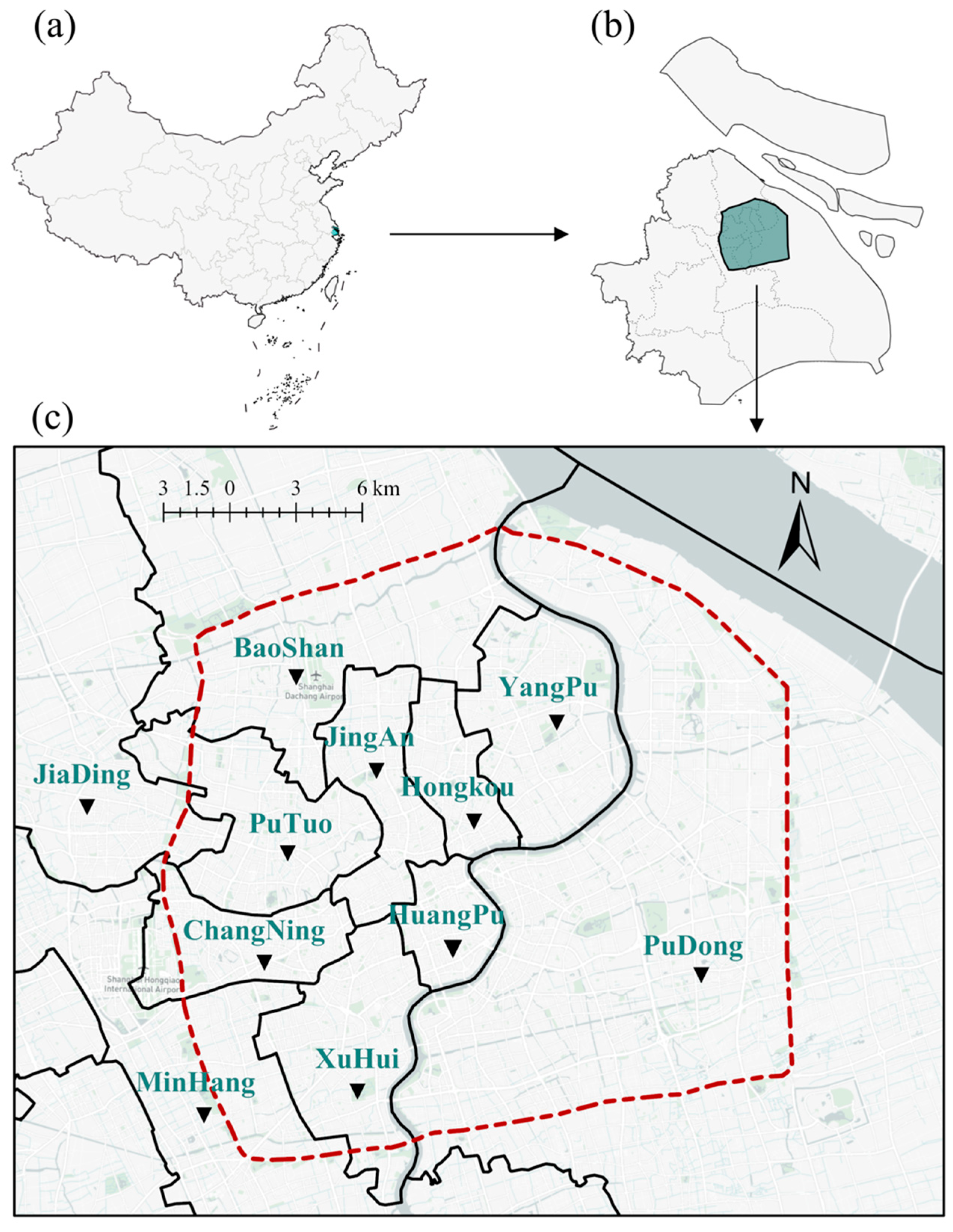
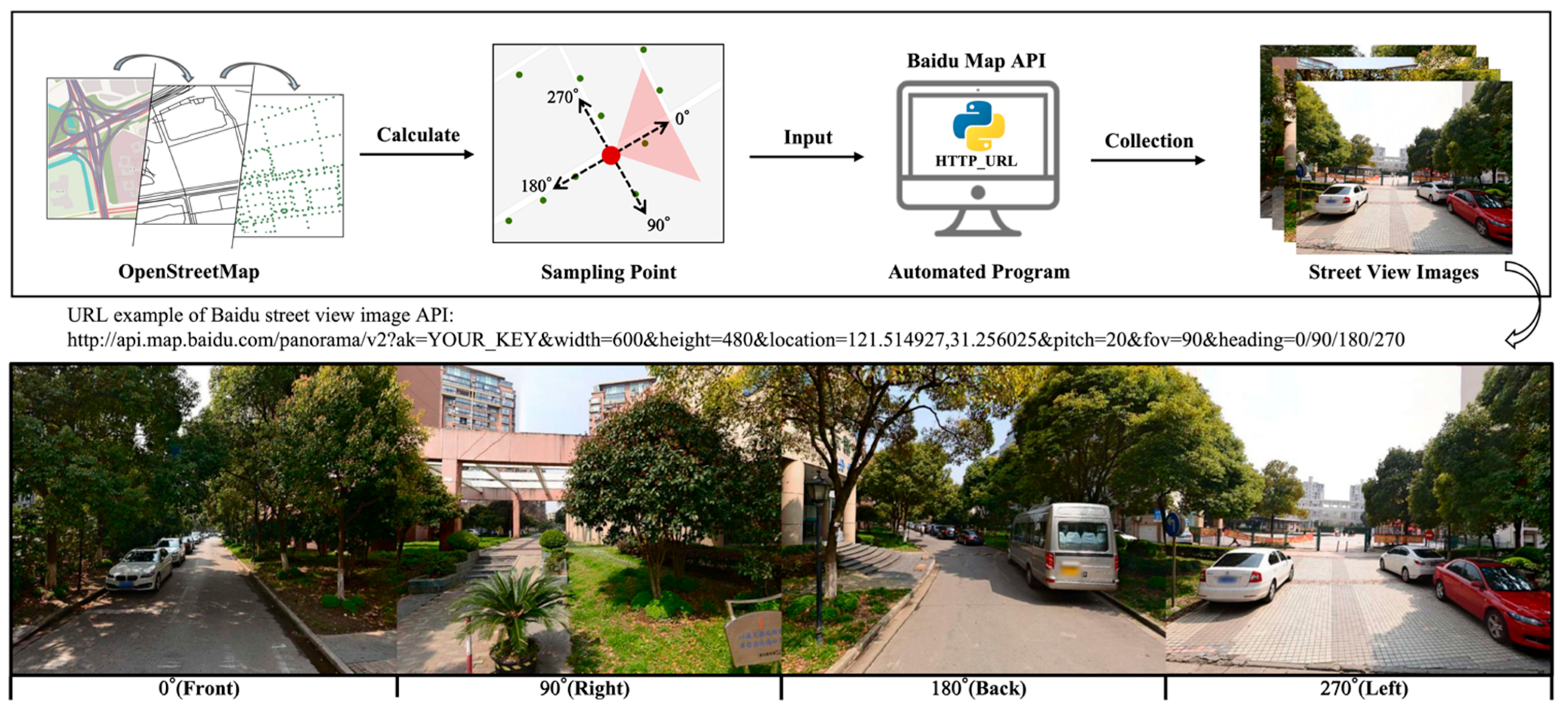
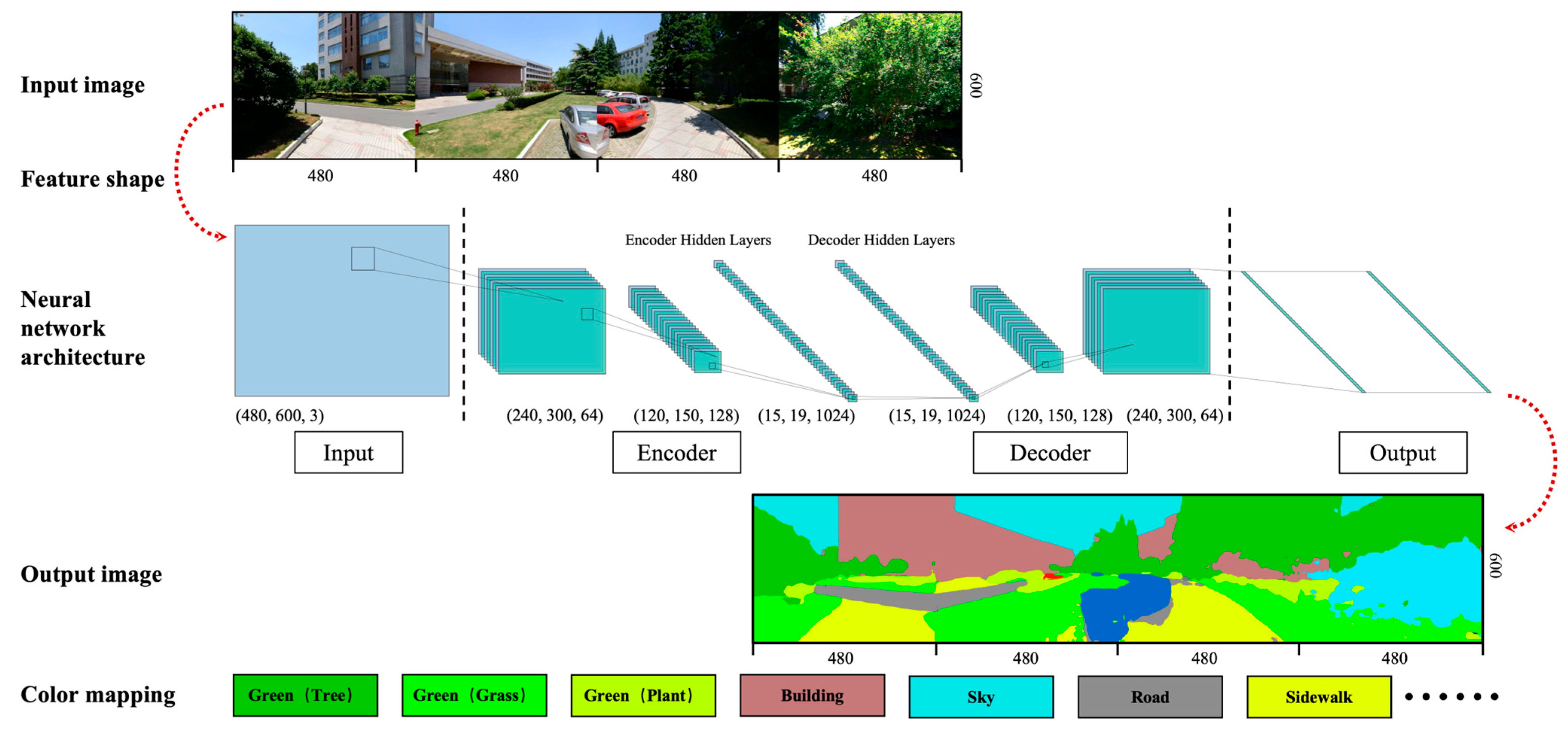

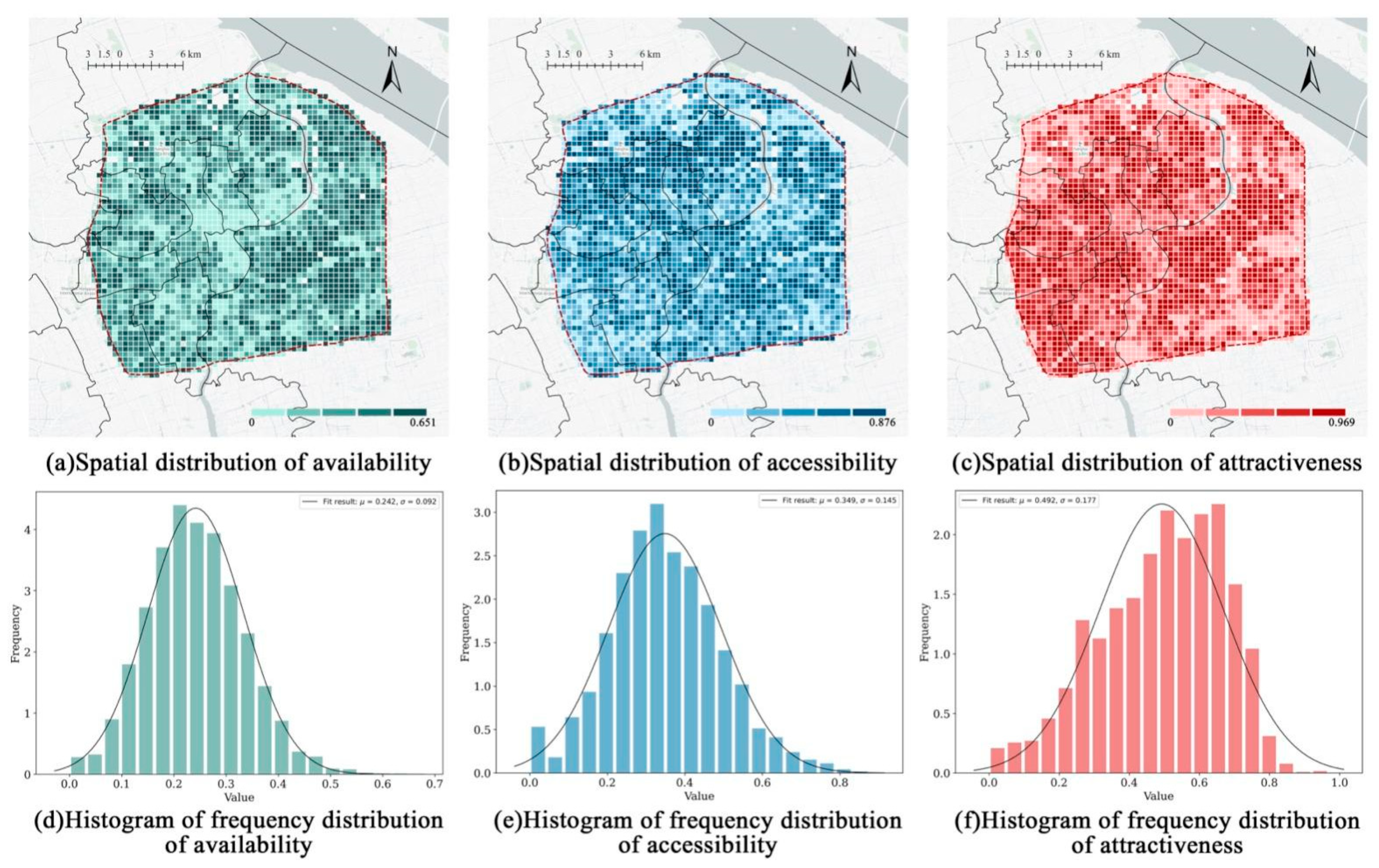
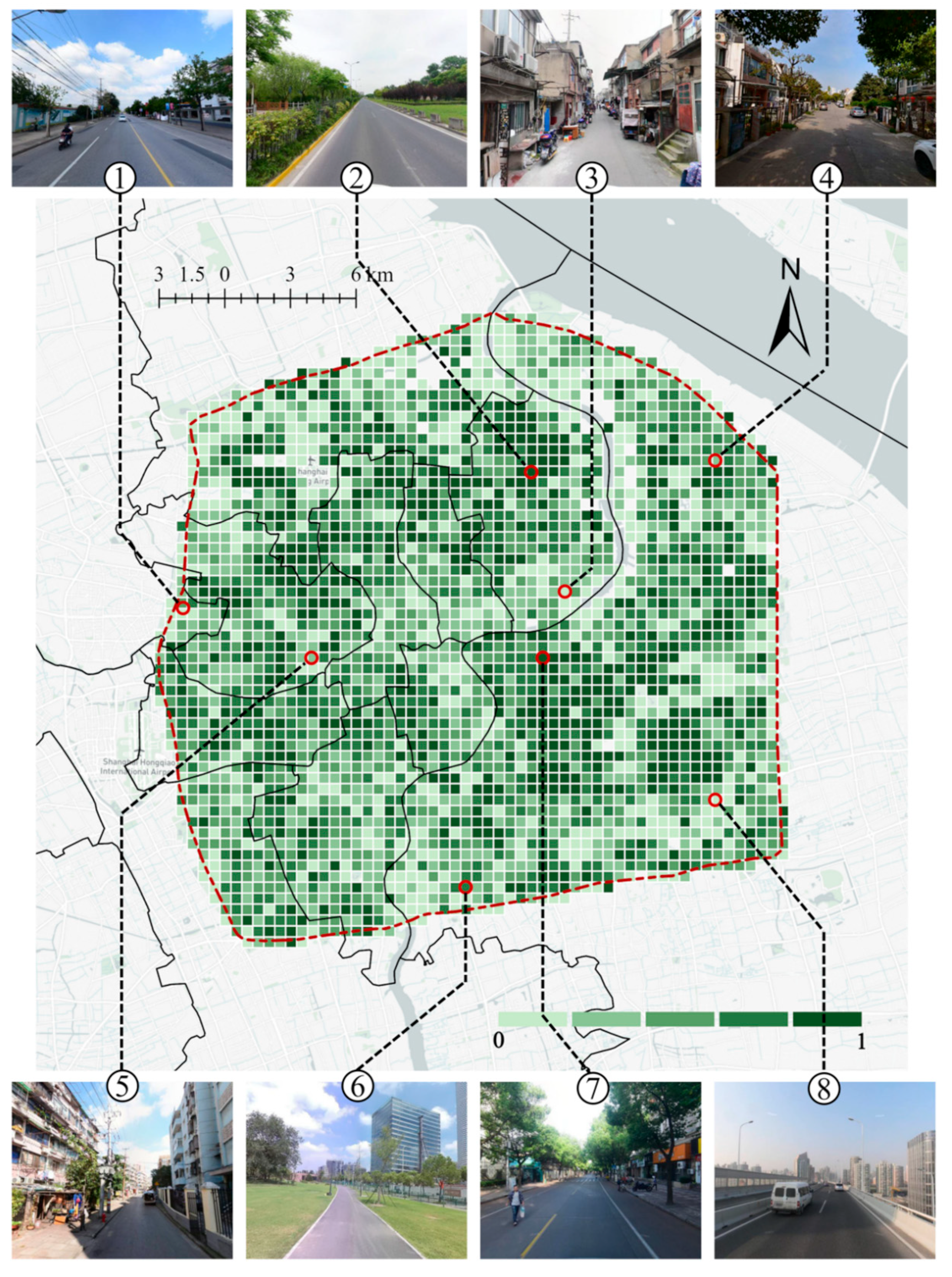
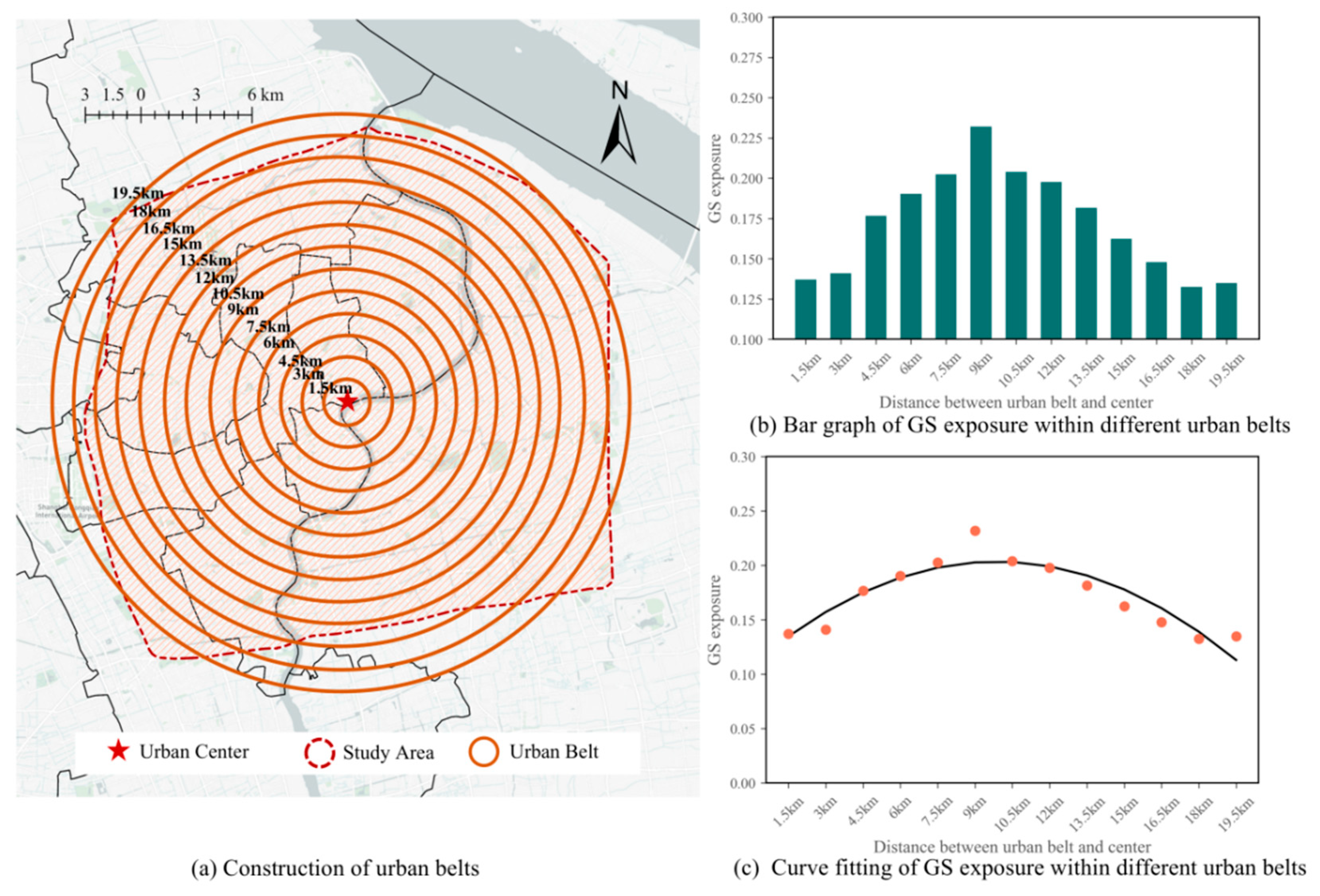
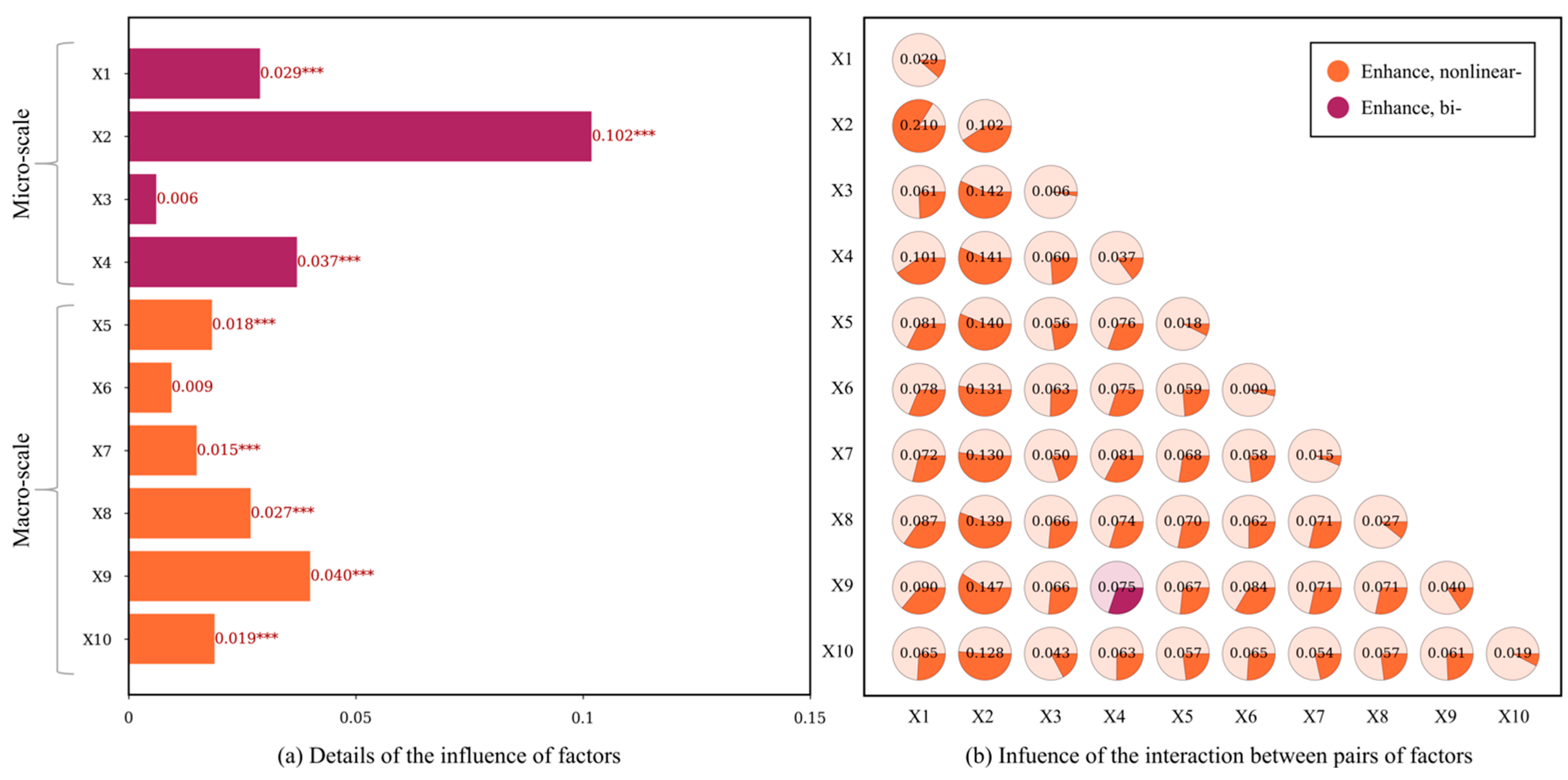
| POI Types | Categories | Number | Percentage |
|---|---|---|---|
| Residential | Commercial building, residential building, residential community. | 39,108 | 4.54% |
| Enterprise | Enterprise, company, factory. | 149,511 | 17.36% |
| Commercial | Food, beverage, shopping mall, market, store, theatre, bank, security company, insurance company. | 506,769 | 58.86% |
| Public service | Hospital, school, governmental organization, social group, management institution, logistics site, human services center, repair site. | 127,788 | 14.84% |
| Entertainment | Scenic spot, park, open square, tourist attraction, gym, leisure place. | 37,852 | 4.40% |
| Variables (Unit) | Min. | Max. | Mean | SD |
|---|---|---|---|---|
| Dependent variable | ||||
| GS exposure | 0 | 1 | 0.177 | 0.129 |
| Independent variables | ||||
| Microscale built environment | ||||
| Building view index | 0 | 0.552 | 0.156 | 0.094 |
| Sky view index | 0 | 0.504 | 0.190 | 0.088 |
| Roadway view index | 0.001 | 0.407 | 0.241 | 0.057 |
| Sidewalk view index | 0 | 0.251 | 0.054 | 0.028 |
| Macroscale built environment | ||||
| Building density | 0 | 5.225 | 1.224 | 0.724 |
| Street intersections (N) | 0 | 193 | 13.794 | 18.636 |
| Street density (m/m2) | 0 | 57.466 | 12.515 | 8.088 |
| POI diversity | 0 | 1.591 | 0.981 | 0.345 |
| POI quantity (N) | 0 | 2088 | 136.485 | 190.507 |
| Residential POIs (N) | 0 | 70 | 8.244 | 9.572 |
| Enterprise POIs (N) | 0 | 236 | 18.156 | 25.872 |
| Commercial POIs (N) | 0 | 1959 | 88.481 | 146.685 |
| Public service POIs (N) | 0 | 303 | 15.072 | 20.648 |
| Entertainment POIs (N) | 0 | 90 | 6.532 | 9.573 |
| Transit stops (N) | 0 | 75 | 2.141 | 2.829 |
| Principal Component | Eigenvalues | Variance Explained (%) | Cumulative Variance Explained (%) |
|---|---|---|---|
| PC1 | 1.603 | 53.4 | 53.4 |
| PC2 | 1.006 | 33.5 | 86.9 |
| PC3 | 0.393 | 13.1 | 100.0 |
| Metrics | PC1 | PC2 | PC3 |
|---|---|---|---|
| Availability | 0.000 | 0.000 | 1.000 |
| Accessibility | 0.000 | 1.000 | 0.000 |
| Attractiveness | 1.000 | 0.000 | 0.000 |
| Microscale Built Environment | Macroscale Built Environment | ||
|---|---|---|---|
| F-Statistic | 128.839 *** | F-Statistic | 13.449 *** |
| Breusch–Pagan test | 253.335 *** | Breusch–Pagan test | 50.083 *** |
| Koenker–Bassett test | 99.787 *** | Koenker–Bassett test | 22.656 *** |
| Lagrange multiplier (lag) | 640.411 *** | Lagrange multiplier (lag) | 855.456 *** |
| Robust LM (lag) | 60.517 *** | Robust LM (lag) | 34.975 *** |
| Lagrange multiplier (error) | 583.391 *** | Lagrange multiplier (error) | 822.696 *** |
| Robust LM (error) | 3.497 *** | Robust LM (error) | 2.216 *** |
| Variables | OLS | SLM | SEM | |||
|---|---|---|---|---|---|---|
| Coef. (SE) | p-Value | Coef. (SE) | p-Value | Coef. (SE) | p-Value | |
| Microscale built environment | ||||||
| Building view index | −0.479 (0.031) | <0.001 *** | −0.373 (0.028) | <0.001 *** | −0.376 (0.035) | <0.001 *** |
| Sky view index | −0.694 (0.036) | <0.001 *** | −0.498 (0.033) | <0.001 *** | −0.548 (0.038) | <0.001 *** |
| Roadway view index | 0.040 (0.042) | 0.338 | −0.029 (0.038) | 0.449 | −0.029 (0.046) | 0.523 |
| Sidewalk view index | 0.296 (0.105) | <0.001 *** | 0.263 (0.094) | 0.005 ** | 0.301 (0.102) | <0.001 *** |
| Micro R2 | 0.162 | 0.321 | 0.315 | |||
| Micro LL | 1910 | 2128 | 2112 | |||
| Micro AIC | −3809 | −4244 | −4213 | |||
| Macroscale built environment | ||||||
| Building density | 0.017 (0.004) | <0.001 *** | 0.012 (0.003) | <0.001 *** | 0.016 (0.004) | <0.001 *** |
| Street intersection | 1.275 × 10−4 (1.524 × 10−4) | 0.403 | 1.833 × 10−4 (1.332 × 10−4) | 0.169 | 2.867 × 10−4 (1.524 × 10−4) | 0.060 |
| Street density | 8.987 × 10−4 (3.529 × 10−4) | 0.011 * | 2.147 × 10−4 (3.085 × 10−4) | 0.487 | 1.648 × 10−4 (3.502 × 10−4) | 0.638 |
| POI diversity | 0.036 (0.007) | <0.001 *** | 0.018 (0.007) | 0.007 ** | 0.014 (0.007) | 0.049 * |
| POI quantity | −3.228 × 10−5 (1.584 × 10−5) | 0.042 * | −2.607 × 10−5 (1.384 × 10−5) | 0.060 | −1.333 × 10−5 (1.572 × 10−5) | 0.396 |
| Transit stops | 0.001 (0.001) | 0.297 | 0.001 (0.001) | 0.410 | 0.001 (0.001) | 0.402 |
| Macro-R2 | 0.029 | 0.257 | 0.256 | |||
| Macro-LL | 1713 | 1988 | 1985 | |||
| Macro-AIC | −3413 | −3960 | −3956 | |||
Disclaimer/Publisher’s Note: The statements, opinions and data contained in all publications are solely those of the individual author(s) and contributor(s) and not of MDPI and/or the editor(s). MDPI and/or the editor(s) disclaim responsibility for any injury to people or property resulting from any ideas, methods, instructions or products referred to in the content. |
© 2024 by the authors. Licensee MDPI, Basel, Switzerland. This article is an open access article distributed under the terms and conditions of the Creative Commons Attribution (CC BY) license (https://creativecommons.org/licenses/by/4.0/).
Share and Cite
Zhang, T.; Wang, L.; Hu, Y.; Zhang, W.; Liu, Y. Measuring Urban Green Space Exposure Based on Street View Images and Machine Learning. Forests 2024, 15, 655. https://doi.org/10.3390/f15040655
Zhang T, Wang L, Hu Y, Zhang W, Liu Y. Measuring Urban Green Space Exposure Based on Street View Images and Machine Learning. Forests. 2024; 15(4):655. https://doi.org/10.3390/f15040655
Chicago/Turabian StyleZhang, Tianlin, Lei Wang, Yike Hu, Wenzheng Zhang, and Yuyang Liu. 2024. "Measuring Urban Green Space Exposure Based on Street View Images and Machine Learning" Forests 15, no. 4: 655. https://doi.org/10.3390/f15040655





